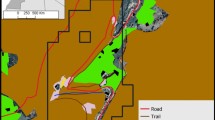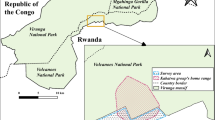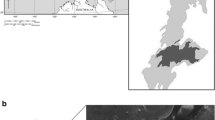Abstract
Much has been written about insect damage to standing crops, but an area that has received little attention within agricultural development, conservation, and primatological literature is that of primates and the potential damage they can cause to farmers' fields. This is likely to become an increasingly important issue for people interested in primates, as conservation projects adopt a more integrated approach to take account of local people's perspectives and needs. The aim of this paper is to examine the impact of crop raiding by primates, particularly baboons, on farmers living around the southern edge of the Budongo Forest Reserve, Uganda. I use data gathered during monthly farm surveys and informal discussion groups, along with time budget data, to demonstrate that 1) baboons can cause extensive damage to field crops, such as maize and cassava; 2) proximity of the farm to the forest edge and the presence or absence of neighboring farms affect the likelihood of any farm sustaining crop damage from baboons; and 3) in addition to the direct costs associated with crop losses attributed to baboon foraging activity, there are indirect costs of baboon crop raiding such as increased labor demands to protect crops from them and, occasionally, to replant crop stands badly damaged by baboons. These results have important implications for future primate conservation policy and practice.
Similar content being viewed by others
REFERENCES
Altmann, J. (1974). Observational study of behaviour sampling methods. Behaviour 49: 229-265.
Atteh, O. D. (1984). Nigerian farmers perception of pests and pesticides. Ins. Sci. Appl. 5: 213-220.
Boulton, A. M., Horrocks, J. A., and Baulu, J. (1996). The Barbados vervet monkey (Cercopithecus aethiops sabaeus): Changes in population size and crop damage 1980-1994. Int. J. Primatol. 17: 831-844.
Conover, M. R., and Decker, D. J. (1991). Wildlife damage to crops: Perceptions of agricultural and wildlife professionals in 1957 and 1987. Wildlife Soc. Bull. 19: 46-52.
Else, J. G. (1991). Nonhuman primates as pests. In Primate Responses to Environmental Change. Box, H. O. ed. pp. 115-165. London: Chapman & Hall.
Forthman-Quick, D. L. (1986). Activity budgets and the consumption of human foods in two troops of baboons (Papio anubis) at Gilgil, Kenya. In Primate Ecology and Conservation. Else, J. G., and P. C. Lee, eds. pp. 221-228. New York: Cambridge University Press.
Forthman-Quick, D. L., and Demment, D. (1988). Dynamics of exploitation: Differential energetic adaptations of two troops of baboons to recent human contact. In Ecology and Behaviour of Food-Enhanced Primate Groups. Fa, J. E. and Southwick, C. H. eds. pp. 25-51. New York: Alan R. Liss, Inc.
Hill, C. M. (1997). Crop-raiding by wild animals: The farmers' perspective in an agricultural community in western Uganda. Int. J. Pest Manag. 43: 77-84.
Horrocks, J., and Baulu, J. (1994). Food competition between vervets (Cercopithecus aethiops sabaeus) and farmers in Barbados: Implications for management. Rev. Ecol. (Terre Vie) 49: 281-294.
Howard, P. C. (1995). The Economics of Protected Areas in Uganda: Costs, Benefits and Policy Issues. MSc, University of Edinburgh.
Infield, M. (1988). Attitudes of a rural community towards conservation and a local conservation area in Natal, South Africa. Biol. Conserv. 45: 21-46.
King, F. A., and Lee, P. C. (1987). A brief survey of human attitudes to a pest species of primate-Cercopithecus aethiops. Primate Conserv. 8: 82-84.
Marples, W. R. (1976). Adaptations of crop-raiding baboons in Kenya. Amer. J. Phys. Anthropol. 45: 309-316.
Mascarenhas, A. (1971). Agricultural vermin in Tanzania. In Studies in East African Geography and Development. Ominde, S. H., ed. London: Heinemann Educational Books Ltd.
Naughton-Treves, L. (1996). Uneasy neighbors: Wildlife and farmers around Kibale National Park, Uganda. Unpublished PhD thesis, University of Florida.
Naughton-Treves, L. (1998). Predicting patterns of crop damage by wildlife around Kibale National Park, Uganda. Conserv. Biol. 12: 156-168.
Oyaro, H., and Strum, S. (1984). Shifts in foraging strategies as a response to the presence of agriculture. Int. J. Primatol 5: 371.
Pirta, R. S., Gadgil, M., and Kharshikar, A. V. (1997). Management of the rhesus monkey Macaca mulatta and hanuman langur Presbytis entellus in Himachal Pradesh, India. Biol. Conserv. 79: 97-106.
Strum, S. C. (1994). Prospects for management of primate pests. Revue Ecologie (Terre Vie) 49: 295-306.
Vansina, J. (1990). Paths in the Rainforest. Toward a History of Political Tradition in Equatorial Africa. Madison: University of Wisconsin Press.
Western, D. (1994). Ecosystem conservation and rural development: The case of Amboseli. In Natural Connections: Perspectives in Community-based Conservation. Western, D., Wright, R. M., and Strum, S. C. A. E. eds. pp. 15-52. Washington DC & Covelo, CA: Island Press.
Rights and permissions
About this article
Cite this article
Hill, C.M. Conflict of Interest Between People and Baboons: Crop Raiding in Uganda. International Journal of Primatology 21, 299–315 (2000). https://doi.org/10.1023/A:1005481605637
Issue Date:
DOI: https://doi.org/10.1023/A:1005481605637




